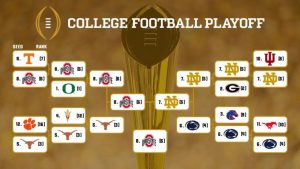
When the Texas Longhorns and Ohio State Buckeyes face off in one of the most anticipated matchups of the 2025 college football season, fans expected a primetime showdown under the lights. Instead, what they got was something far less ideal: an early kickoff that has left fans, players, and even some analysts scratching their heads. The decision to schedule such a high-profile, marquee matchup in a non-primetime slot has drawn widespread criticism across the college football world, with many questioning whether the decision-makers understand the magnitude of this clash—or the fanbases involved.
At the heart of the controversy is a kickoff time slated for 11 a.m. Central, which translates to a noon start on the East Coast. While early kickoffs are common in college football, they are generally reserved for less consequential games—non-conference tune-ups, regional matchups, or games with limited national intrigue. This, however, is Texas vs. Ohio State—two of the most iconic programs in the sport’s history, each boasting passionate national followings, elite rosters, and legitimate College Football Playoff ambitions. For many, the early kickoff is not only disappointing but borderline disrespectful to the scope and scale of what this game represents.
The decision, unsurprisingly, appears to be rooted in television logistics and the evolving media landscape of college sports. With conference realignment reshaping traditional power structures and TV networks paying astronomical sums for broadcast rights, kickoff times are increasingly dictated by programming needs rather than competitive fairness or fan experience. FOX, which has embraced its “Big Noon Kickoff” branding strategy, has prioritized placing marquee games in that early slot in an effort to capture viewers before the more crowded afternoon and evening slates. While the approach has yielded strong ratings in some cases, applying that model to a game like Texas vs. Ohio State feels like a miscalculation.
Fans of both programs have been particularly vocal in their displeasure. Texas supporters, many of whom face long drives or early flights to get to Austin from across the state and beyond, are frustrated with the logistical challenges that come with such an early start. Tailgating culture—a key part of the college football experience in Texas—is significantly hampered by an 11 a.m. kickoff. It’s hard to build the kind of pregame energy that defines fall Saturdays when fans are being asked to arrive at the stadium gates by 9:30 in the morning. Many have also expressed concerns about the impact on the local economy, with early games typically leading to shorter stays and lower spending on food, lodging, and entertainment.
Ohio State fans, for their part, are equally unhappy. While the noon ET kickoff is more familiar for Big Ten teams, the magnitude of this particular game demanded a stage befitting its stakes. For a team accustomed to night games in the Horseshoe or primetime showdowns against Michigan and Penn State, seeing a game of this caliber relegated to the morning slate is a tough pill to swallow. The Buckeye faithful expected a grand stage; instead, they feel shortchanged by a scheduling decision that seems more focused on network branding than on celebrating college football excellence.
Players and coaches, though generally more diplomatic in public comments, have not been immune to the discussion either. While both teams will undoubtedly be prepared and motivated regardless of kickoff time, the impact of early starts on game preparation, sleep cycles, and physical readiness is not insignificant. For Texas, which will need to be locked in at the crack of dawn to face one of the nation’s most potent offenses, the margin for error is slim. Even a slightly sluggish start could prove costly in a game with such narrow margins.
The criticism is not limited to just fans of the two programs involved. National voices across sports media have chimed in, echoing the sentiment that this is a missed opportunity for college football as a whole. A matchup of this magnitude—featuring blue-blood programs, potential first-round NFL Draft picks, and playoff implications—should have been the centerpiece of the day, not part of the morning warmup. Many analysts have pointed to the 2005 Texas-Ohio State game in Columbus, a legendary primetime battle under the lights, as the blueprint for how such games should be showcased. That contest, which featured Vince Young and Troy Smith trading blows in a top-five showdown, was etched into the sport’s memory in part because of its dramatic setting and national spotlight. This year’s game could still be great—but it will now have to fight against the constraints of the early time slot to capture the same magic.
There’s also the question of fairness. While television contracts dictate much of the scheduling process, the lack of input from schools and conferences on games of this magnitude has drawn criticism. With Texas now part of the SEC and Ohio State a cornerstone of the Big Ten, this cross-conference clash was already a rarity. That rarity, critics argue, should have elevated the game’s profile, not diminished it. Fans want to see the best teams playing under the brightest lights, not buried in the early window where many casual viewers are just waking up or still caught up in Saturday morning routines.
For Texas, this game also serves as a critical test of its arrival on the national stage. After years of rebuilding, the Longhorns enter 2025 with legitimate championship aspirations and a roster stacked with elite talent. Playing Ohio State provides a chance to validate that hype, galvanize the fanbase, and send a message to the college football world. But doing so in a less-than-ideal environment, one where the crowd energy might not reach its full potential and the buildup feels muted, adds an unnecessary wrinkle to an already challenging assignment.
Of course, both teams will still play the game. And in the end, talent and execution will matter more than the time on the clock. But the frustration remains because fans sense that something special is being compromised. College football thrives on tradition, passion, and spectacle—and part of that spectacle is the anticipation and atmosphere that comes with big-time night games. Taking that away from a matchup of this caliber feels like a disservice to everyone involved.
The broader trend of early kickoffs for marquee games has also raised alarms among college football traditionalists. While TV ratings and revenue are important, the soul of the sport lies in its pageantry and fan engagement. When decisions are made purely through a commercial lens, without regard for the fan experience or competitive equity, it risks alienating the very people who make college football unique. If the sport continues down this path—sacrificing atmosphere for airtime—it may find that the short-term gains in viewership come at the cost of long-term loyalty and connection.
For now, all eyes will still be on Austin when the Longhorns and Buckeyes take the field. The game itself promises to be a heavyweight battle, with two of the nation’s best programs jockeying for early-season supremacy. But the shadow of the early kickoff will linger. It will be a reminder of how college football is changing—and not always for the better.
The hope, among fans and analysts alike, is that this serves as a wake-up call. Big games deserve big stages. And if college football truly wants to honor its biggest matchups, it must do more than just put them on TV—it must celebrate them the way they deserve to be celebrated. Texas vs. Ohio State should have been a night to remember. Instead, it will be a morning to debate. And for many, that’s simply not good enough.





